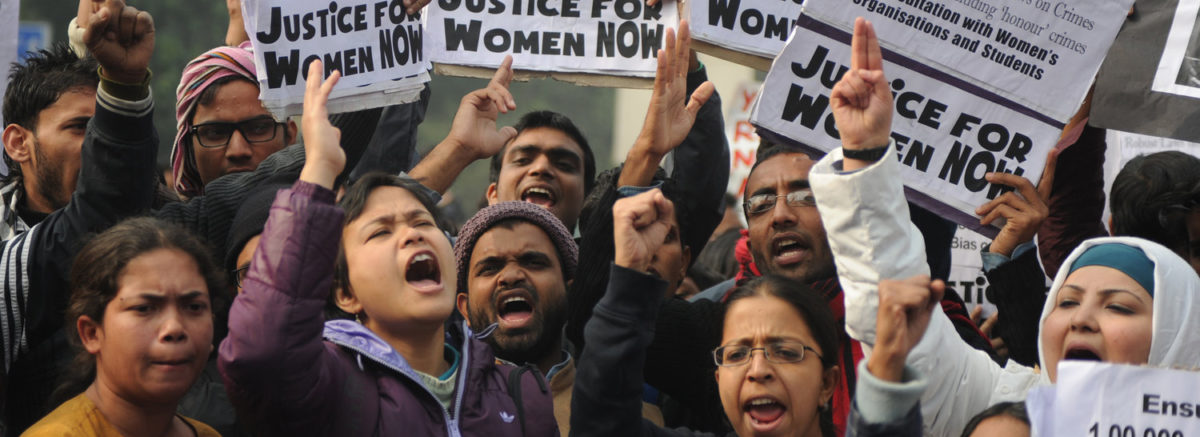Goddess Worship In India
The Hindu lexicon has many goddesses, all of whom we worship. We have Saraswati, the goddess of music and learning, and Lakshmi, the goddess of wealth and prosperity. Some worship the divine feminine energy of Shakti, in Durga, Kali and Parvati. And others valorise women such as Lakshmibai, singing Bundeley Harbolon key munh hamney suni kahani thi, khoob ladi mardani woh to Jhansi wali Rani thi — the Bandelas and Harbolas sang the story, she fought against the British like a man, such was the Queen of Jhansi. With every sensational rape case in India, people say that we should respect women because they are akin to goddesses. However, for a country obsessed with goddess worship the reality is that women are burnt for dowry, killed in the womb, or repeatedly sexually violated and murdered. What does that say about India?
Bharat Mata and Honour
When we look to deconstruct the ideal of the ‘goddess’, it is important to understand that the use of the ‘goddess’ to symbolise Indian femininity brings up questions of representation and marginalisation. For much of history, we have compared women in upper-caste, Hindu households to goddesses. An example of this is the production of a certain kind of Indian nationalism that is wrapped up in the symbolism of Bharat Mata, or Mother India, as an icon of purity, motherhood and fertility.
Equating Indian femininity with upper-caste Hindu symbolism is doubly troubling because it leaves out huge tracts of Indian women, refusing to represent marginalised Dalit women, Adivasi women, women of non-Hindu backgrounds, North-eastern women, queer women and trans women. Using the ‘goddess’ symbology only detaches these groups of women further from the idea of Indian womanhood or femininity. The symbol of Bharat Mata equates the honour of the nation with the preservation of the ‘honour’ of women. A common refrain from Indian feminists is that the nation’s honour is not in a woman’s vagina; it is not up to women to safeguard ‘national honour’. As Kamla Bhasin said on Satyamev Jayate:
When I’m raped, people say that I’ve lost my honour. How did I lose my honour? My honour is not in my vagina. It is a patriarchal idea that my rape will defile the honour of my community. I’d like to tell everyone, “Why did you place your community’s honour in a woman’s vagina?” We did not place it there.
We see this in the production of a graphic novel series called Priya’s Shakti, inspired by the horrific gangrape incident of 2012. In Priya’s Shakti, we see how a gangrape victim becomes powerful when Parvati, an aspect of Shakti, takes over her body and imbues her with the superhuman and goddess-like powers. The intention of the series is agreeable. And it is encouraging to see different mediums discuss issues such as rape, acid attacks, and sex trafficking. But, several questions comes to mind. Why is it that previous well-known and infamous rape cases of women such as Bhanwari Devi, Mathura or Thangjam Manorama did not provoke such artistic efforts? And, why is it that we assume that women may only get justice if they become ‘goddesses’? Why can we not afford women justice without the introduction of the ‘goddess’ imagery?
Shakti and It’s Impact
The Hindu tradition has long considered women as the vessels of shakti. It identifies women as having both creative and destructive powers. This identification is deeply problematic! It leads society in labelling women as either saint or sinners, with very little room in between. If women, like benevolent Hindu goddesses exhibit forgiveness, compassion and a tolerance of other people inflicting pain on them, then patriarchal society deigns to accept them. If they do not exhibit such goddess-like traits, perhaps attempting to be assertive or exhibit their independence of thought, then the same society that worships them, turns on them and labels them as destructive and disruptive to family and social structures.
In 2013, an ad agency, Taproot, debuted a campaign condemning domestic violence called Abused Goddesses. Media outlets such as BuzzFeed and Huffington Post called the campaign ‘incredibly powerful’ and having had a ‘powerful impact’. The pictures are striking, shot in the style of kitschy calendar art, depicting Hindu goddesses with bruises and cuts as they posed traditionally. I couldn’t help but ask, who exactly was this impacting? A middle-aged devout Hindu man who recites the Durga Chalisa every day would still be beating up his wife for putting too much salt in his lunch. Did this campaign make that man stop and think that he was about to strike Durga as he rushed to hit his wife the next time?
It is essential to understand that goddess worship does not translate into better life opportunities or a higher living standard for women. It is a tokenistic representation, rather than a representation of the plurality of Indian women.
Let Women Be
In a country where Durga is worshipped over nine days, where Lakshmi and Saraswati certainly have more prominent festivals than Kartik or Ganesh, we also see regressive practices flourishing. From female infanticide, honour killings, dowry burnings, sexual abuse and harassment, acid attacks, domestic violence and rape, India ranks as one of the world’s worst places to be a woman. What we need to remember when we equate a woman with a goddess, is that a goddess is not human; instead, she is divine. We revere, worship goddess and put them on a pedestal, away from the inconsistency of humanity. But the problem is that women are actual. Women are not divine. Women are human, and women have flaws. The goddesses we pray to are not subject to domestic violence or sexual assault. Real women are.
About The Author

Swagata is currently studying law and global politics and is a keen student of history. She has been an active campaigner for awareness about sexual assault keeping institutions accountable.
Some other blog posts you might like:
Image Source: Sajjad Hussain for NPR
Editor: Dr. Shruti Kapoor
